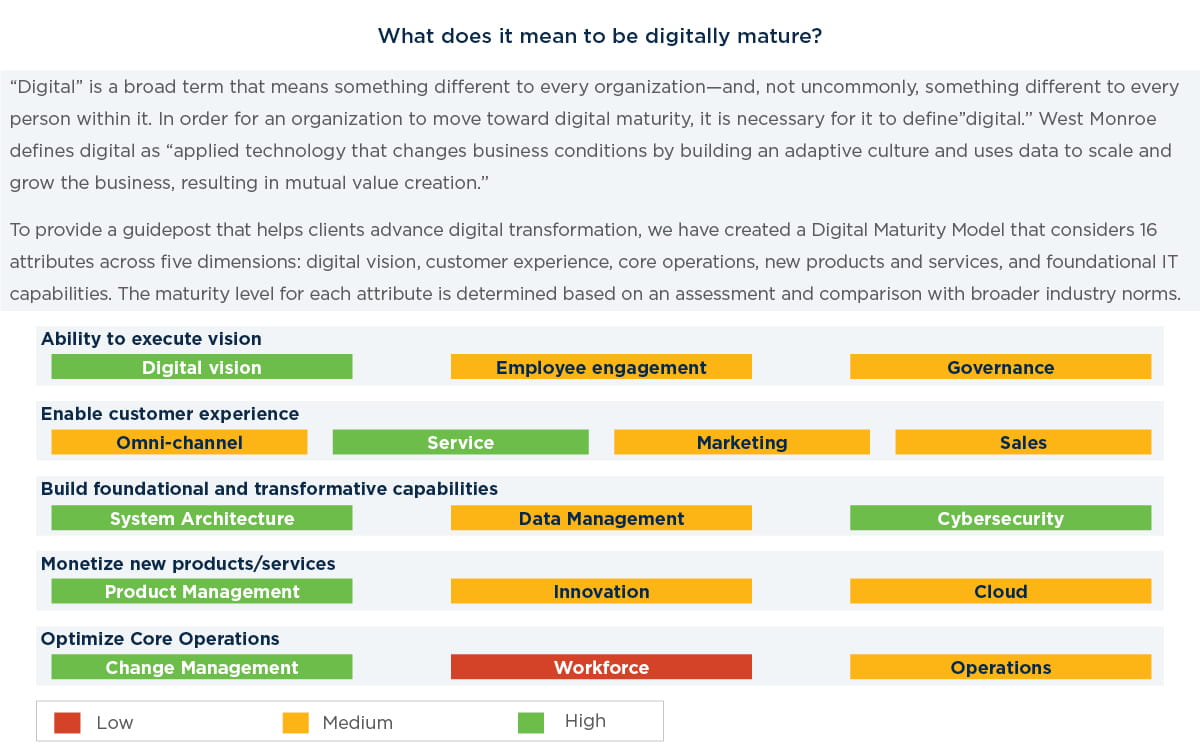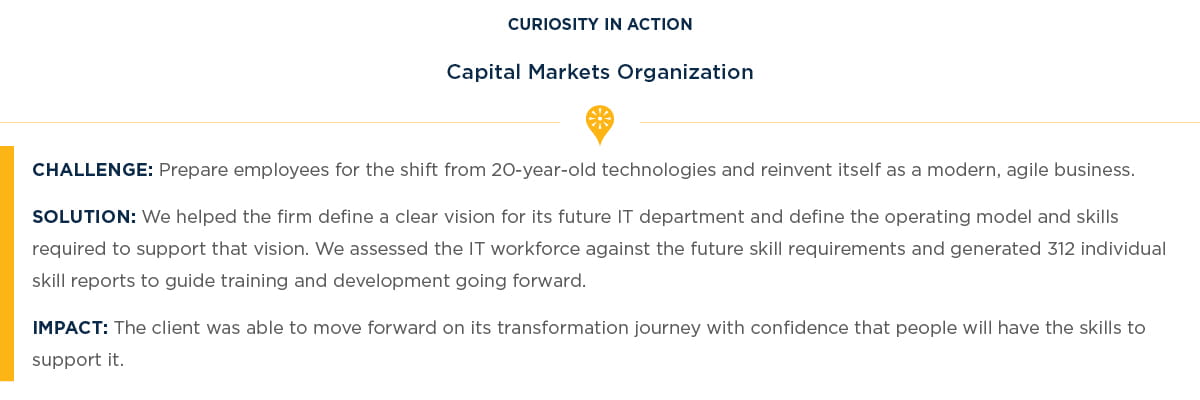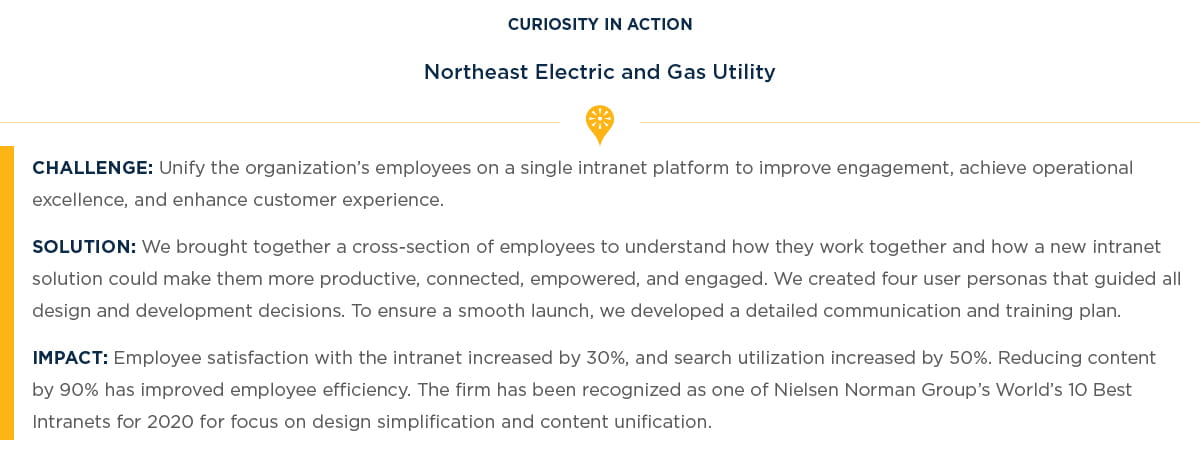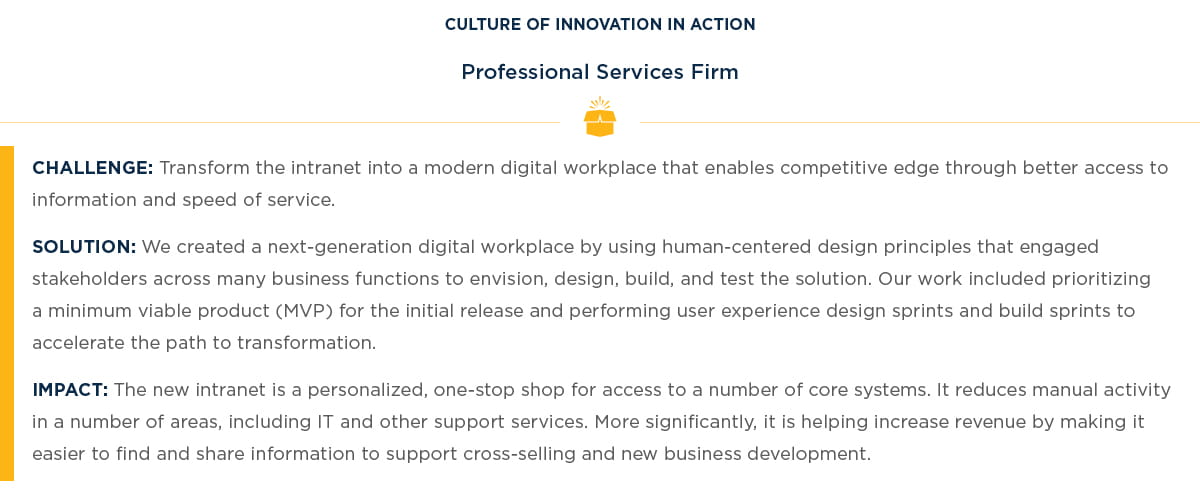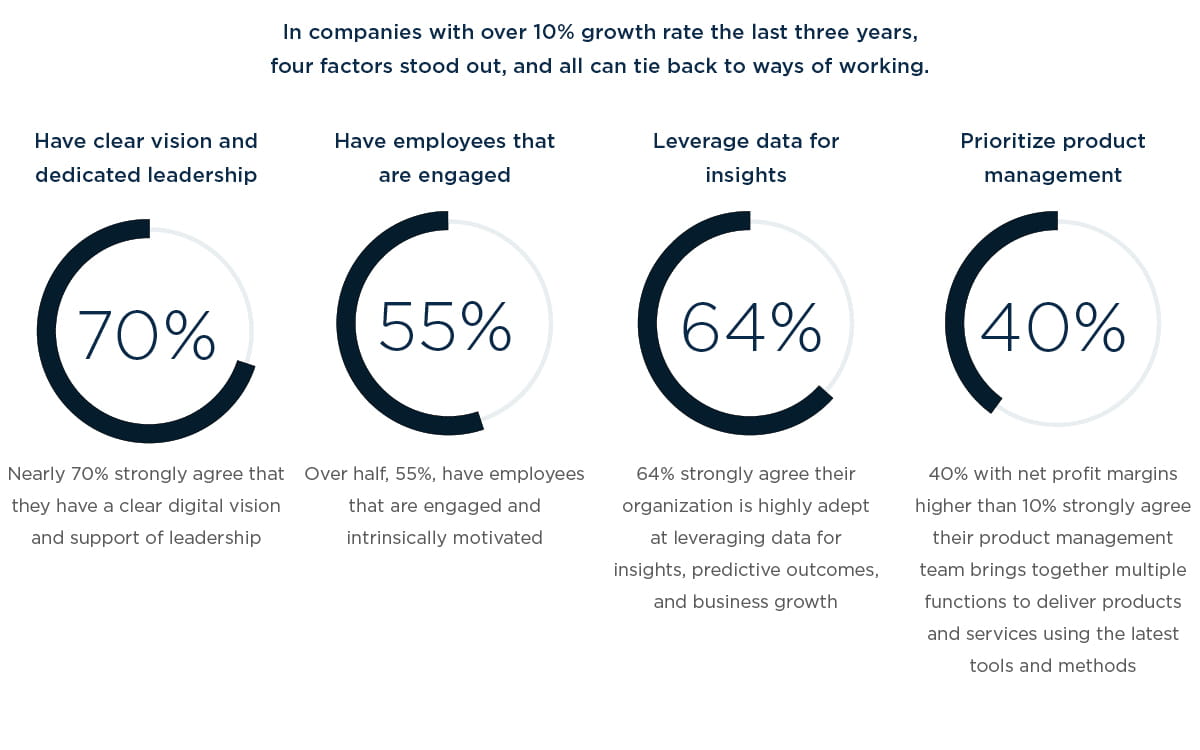
January 2020 | Point of View
Empowering employees: Strategies to enable a winning digital business
Customers and employees demand higher levels of digital maturity. Organizational change management is critical for digital transformation.
Executive Summary
Four goals that can help lay the groundwork for sustainable change:
- Provide clarity around your digital vision and priorities. Employees need to understand what success looks like and why the organization requires change. They also need to see that change is valuable for them and for customers. Because elevating digital maturity will involve numerous projects, you will need to prioritize the ”must haves” over the ”nice-to-haves.”
- Engage and empower employees by fostering their curiosity. Digitally mature companies encourage employees to experiment and innovate while equipping them to resolve challenges. You will need a change leader with the right qualities to inspire, influence, and encourage collaboration. You will also need to promote a growth mindset by helping employees develop and use new competencies as your operations become more digital.
- Leverage data to draw sound conclusions. Data is the lifeblood of a digitally mature organization and is essential to driving change. Good data enables you to calculate, understand, and articulate the value you expect from digital initiatives. Employees at all levels must be empowered and equipped to make data-driven decisions to respond to and satisfy customers.
- Foster a culture of innovation. Innovation is key to staying ahead of both known and emerging competitors. For innovation to flourish, your organization must elevate cross-functional collaboration, adopt the product management model that drives success for the digitally mature, and strengthen the partnership between the business and IT function. As you take these steps, it will be important to balance freedom to explore with incentives to accelerate value from innovation.
Introduction
Open your favorite online business publication. You’re likely to see stories of digital transformation and customer experience success. Perhaps it’s about Domino’s advanced pizza-tracking technology improving experiences for both customers and stores, helping spur double-digit global sales growth. Maybe it details Target’s ability to track customers’ locations in-store and send personalized deals and recommendations to their smartphones. You might see a report on the success of Starbucks’ mobile application that allows customers to order drinks in advance and pay for them with the app, a capability that generates six million transactions per month.
The ability to offer these mature, effortless, digital customer experiences excites many business executives. But it still eludes most of them. In a recent Gartner study, 87% of senior business leaders said digitization is a company priority, but that the pace of change has been slow: 76% said their digital business transformation is less than 50% complete.
One reason digitally mature companies have risen to that status is their ability to foster a more adaptive culture that views transformation as a journey rather than a destination. As a result, they can pivot and introduce new capabilities quickly to meet evolving customer needs and expectations.
Chapter 1: Successful digital transformation starts from within
Business leaders remain concerned about the lack of digital transformation progress. According to Gartner’s Emerging Risks Report and Monitor, “lagging digitalization” ranks among the top five emerging risks in each of the past four quarters.
While many factors inhibit the ability to become digitally mature (see What does it mean to be digitally mature? below), lack of progress almost always stems from a failure to align new ways of working with the organization’s vision. This underscores the importance of thoughtful change management that institutionalizes new directions, mindsets, and behaviors while also increasing the speed with which an organization can realize the benefits of digital transformation.
Organizational change management is particularly critical for digital transformation because of the industry’s accelerated pace of change. Significant adjustments are difficult in any scenario, but especially when there is so much of it taking place at once.
Consider that the typical organization has undergone five major enterprise changes in the past three years, and nearly 75% of organizations expect to multiply the types of major change initiatives they will undertake in the next three years.
Our own research has studied the characteristics of organizations with strong financial performance to understand the most closely correlated aspects of digital maturity. Specifically, we found that digitally mature organizations establish a clear vision and dedicated leadership, engage employees, and leverage data to produce insight. These organizations also prioritize a “product management” approach to development that brings together people and perspectives across functions to innovate and accelerate new solutions.
These findings make it clear: All strategies an organization must employ to increase its odds of digital success start from within.
Chapter 2: To change successfully, focus on the four C’s
Many organizations go into the process of digital transformation with good intentions and solid plans for managing change, but eventually they get bogged down in the complexity. We have found it effective to focus on four key goals that, if addressed sufficiently, can go a long way toward evolving the way an organization works to support the digital vision. We call these the four C’s: Clarity, Curiosity, Conclusions, and Culture. The pages that follow examine each “C” in more detail, with examples drawn from our work with various clients.
1| Provide clarity around your digital vision and priorities
Executives surveyed for Gartner’s third-quarter 2019 Emerging Risks Monitor Report expressed concerns that digitization efforts may be poorly conceived. "Digital misconceptions,” which previously fell below concerns and pace of change, soared to the top of the list of emerging risks in the survey.
Neil Osmond, VP analyst at Gartner, emphasized the need for a clear vision. “Digital transformation won’t succeed without a common understanding and a clear vision across the organization,” he wrote. “When most people think about digital transformation, they tend to emphasize technologies such as artificial intelligence, chatbots, or automation. But technology issues are usually the easier things to work through. Nontechnological aspects, if not addressed, can mask the depth of organizational transformation required and become serious inhibitors.”
Before your organization can change how it works, employees need to understand what success looks like and why the organization requires change.
We found that digitally mature organizations establish a clear vision and dedicated leadership, engage employees, and leverage data to produce insight. These organizations also prioritize a “product management” approach to development that brings together people and perspectives across functions to innovate and accelerate new solutions. ”
In the digital marketplace, the answer to “why?” should center around how your digital investment and strategy delivers incremental value to customers. This strategy should be based on exercises in design-thinking that reveal what customers value most. As you articulate that value proposition to employees, it is also important to build emotional connections by explaining how change is valuable for employees. For example:
- Software company: Evolving our organizational structure ensures we can deliver a higher quality product to a delighted customer, and it helps each of you grow through career advancement opportunities.
- Personal training company: This new health program ensures you have access to the latest fitness classes, tracking tools, and more to build a healthier you while also driving better health outcomes for your clients.
Elevating digital maturity likely will involve numerous projects, which will require you to prioritize them. Portfolio management—commonly used by IT organizations to process and manage requests—also can be helpful for organizing and managing digital maturity initiatives.
Once you have defined the value proposition for each initiative, determine which are critical “must-haves” to the digital strategy and which are “nice-to-haves” that may have to wait until time and resources are available. One consideration will be the appropriate timing for a particular initiative. For example, your organization may not be ready to pursue building an intranet because it has not yet completed a holistic digital workplace vision and strategy. Therefore, prioritization decisions should always ask, “Are we ready?”
Employees also need clarity around the organization’s priorities so they understand what to expect and can act on the most important requests asked of them. When articulating priorities, consider the sheer amount of communication an individual receives and must filter.
Finally, recognize that it will be challenging to establish clarity without also demonstrating a willingness to invest in change. At the 2019 Gartner IT Symposium/ Xpo, analyst Mark Raskino spoke about the tendency to fund transformation from existing budgets:
[Executives] think they will be able to rob a bit from this budget and save some from the existing IT budget to do digital. You can do digital optimization, potentially, within existing budgets, but if you think you are going to do a transformation without net new investment somewhere, you’re fooling yourself. ”
2| Engage and empower employees by fostering their curiosity
To deliver on your organization’s digital vision, employees will need to be motivated and empowered. These traits will allow them to experiment and innovate without fear of failure, resolve challenges more resiliently, and champion change. They also must know they are supported in doing so.
There are various dimensions to fostering curiosity. At the top of the list is leadership. Just as digital development initiatives require capable and dedicated business or technical leadership, so, too, does change management. Consider the skills required to successfully lead organizational change—for example, technology savviness, collaboration, influence—and identify individuals who will be a good fit. As the digital journey evolves into a more significant program, you will need to identify and prepare change champions at additional levels—project, practice, and business line, among others.
Digital maturity also requires employees to adopt a growth mindset that motivates them to develop and use new skills as operations become more digital.
For many workers, the skill shift will be substantial. According to a World Economic Forum report, the proportion of core skills required to perform a job will change by 42% between 2018 and 2022. Furthermore, recent research by Gartner points to the importance of adaptability and growth; the 2018 study found that 37% of skills that employees use today were learned in the past year.
Employees can build skills in various ways. Training should be part of the mix, but it is important to recognize the value and importance of experiential, on-the-job learning. This tactic helps employees build muscle memory and enables them to deliver their tasks in a more productive manner. The Gartner study found that 57% of employees develop new skills through interactions with colleagues.
It is also important to consider when people need to learn. The Gartner study also found that 66% of employees expect to learn and develop new skills “just in time,” as they need to apply those skills.
Don’t overlook the importance of your digital workplace. It’s the employees’ window into their work and company. With today’s physical distribution of teams across locations, employees often spend most of their day interacting with others through the digital workplace. Its design, therefore, should prioritize functionality that makes it easy for employees to perform new tasks and roles dictated by your digital vision.
3| Leverage data to draw sound conclusions
Data is the lifeblood of the digital organization. Mature digital companies foster a culture that pushes leaders and peers to use data when making decisions.
Good data is essential to determine the value of change and to articulate the results you expect from your digital initiatives. Without well-defined success measures, it will be difficult to inspire leaders to model the right behaviors and also evolve performance management systems and incentive structures to reward desired behaviors.
One way to use data to promote the right behaviors is to communicate “use cases” that demonstrate how a particular change is tangible and measurable. These examples can point to progress that the team is making and the impact of its work. This motivates others to find similar opportunities and demonstrate comparable behaviors.
Data is also essential to making timely and competitive decisions in a rapidly moving digital marketplace. For example, if your digital vision includes innovating and developing new products, you will need good data to guide your investment decisions.
In a digitally mature organization, employees across the organization—particularly in customer-facing roles—are empowered to make data-driven decisions to respond to and satisfy customers. Of course, employees will need better access to data and insight in order to get there.
Consider self-service capabilities, such as an intranet, to enable and encourage employees to use data to make decisions more easily—and makes it easy to do so. Keep in mind that they will also need new skills and competencies for using decision-support tools and interpreting and drawing conclusions from data.
4| Foster a culture of innovation
Ubiquitous access to digital tools means competition can emerge from anywhere at any time. The ability to innovate is essential to stay a step ahead of current and, more importantly, emerging competitors. There are several steps your organization must take for innovation to flourish.
First, it needs to elevate cross-functional collaboration. Organizations with a high digital maturity have changed the way they work to emulate product management models. That means they organize teams differently.
Rather than organizing work within functional silos, they establish cross-functional teams with diverse perspectives that solve problems together and uncover previously unknown opportunities.
Experts and executives at Gartner’s 2019 IT Symposium/ Xpo discussed utilizing this strategy by adopting the mentality of a startup company. Sandy Carter, vice president of Amazon Web Services, explained how small- sized teams encourage idea generation and action. “Big teams,” Carter said, “typically slow or completely stall the testing of new ideas.”
In another session, Jennifer Hyman, co-founder and CEO of Rent the Runway, discussed how innovation must be everyone’s responsibility. “Do not start an innovation team at your organization, because that team is doomed for failure,” she said. “Innovation is the responsibility of every group within the company, and every team has to be given permission to disrupt itself.”
Developing an innovative culture brings a new mandate for collaboration and partnership between your business and IT function, too. To make progress on the digital agenda, the business needs to understand IT capabilities and capacity. Conversely, IT must possess business acumen and an ability to articulate a technical perspective on prioritization and decision-making efforts.
The organization also must find the right balance between freedom to explore and the incentive to drive innovations in the market. Depending on your organization’s digital vision and maturity, it may be appropriate to establish teams that operate differently— some with greater autonomy to innovate and others with an enhanced focus on product management and accelerated value creation.
Innovation and product management require new ways of working rooted in agile methodology. Mature digital organizations increasingly embrace the concept of introducing a minimum viable product (MVP) and then improving it over time. It’s a stronger approach than striving for a full-featured big bang, which, in today’s market, could wind up being irrelevant by the time it is ready for launch.
Another relevant concept is use of a catalyst team tasked with delivering a preliminary pilot of the functionality required to realize your digital vision. Cross-functional catalyst teams can reduce the time required to realize benefits from a pilot while building momentum within the organization where change previously seemed unimaginable. This approach anchors team members in new ways of working that will spread when those team members return back to their original roles.
Conclusion: Take the next steps
From this point forward, your customers and employees will only demand higher levels of digital maturity. A thoughtful approach to change management—focused on the four areas above—will help expedite progress.
Here are some ideas for getting started:
- Review current strategies for listening to both customers and employees, and make sure you are capturing and analyzing that feedback continuously
- Introduce human-centered design principles to help solve problems that customers and employees experience in today’s increasingly digital economy
- If your organization has not already done visioning work around its digital future, get your leaders together for a facilitated session to begin establishing some clarity around what your organization and customer relationships look like a year, two years, and five years into the future. If you have undertaken this type of activity in the past, repeat it. The world is changing so fast that discussions from even six months ago may need a fresh look.
- Identify change leadership candidates who inspire curiosity. Even though advancing digital maturity involves technology-based projects, that doesn’t mean the change leader must be a technologist. Consider those with unique traits for engaging people and galvanizing support. For example, a recent study published in the Harvard Business Review analyzed thousands of 360-degree reviews and found that women outscored men on 17 of the 19 capabilities that differentiate excellent leaders from average or poor leaders. In particular, women rated very highly in their ability to champion change, collaborate, and inspire and motivate others.
- Assess your data management and reporting practices and identify gaps that could prevent managers and employees from accessing and using data to draw conclusions and make timely business decisions.
- Experiment with the concept of a cross-functional catalyst team to drive a short-term initiative. Treat this as a learning exercise from which you can determine how you can use this concept more broadly to accelerate progress toward a culture of innovation.
Our team works with clients to transform internally to support digital transformation goals. Leveraging experience with organizations of all types, we can help design an approach to managing change that suits your culture and operations and supports your digital vision.
